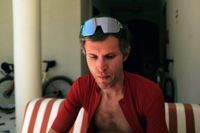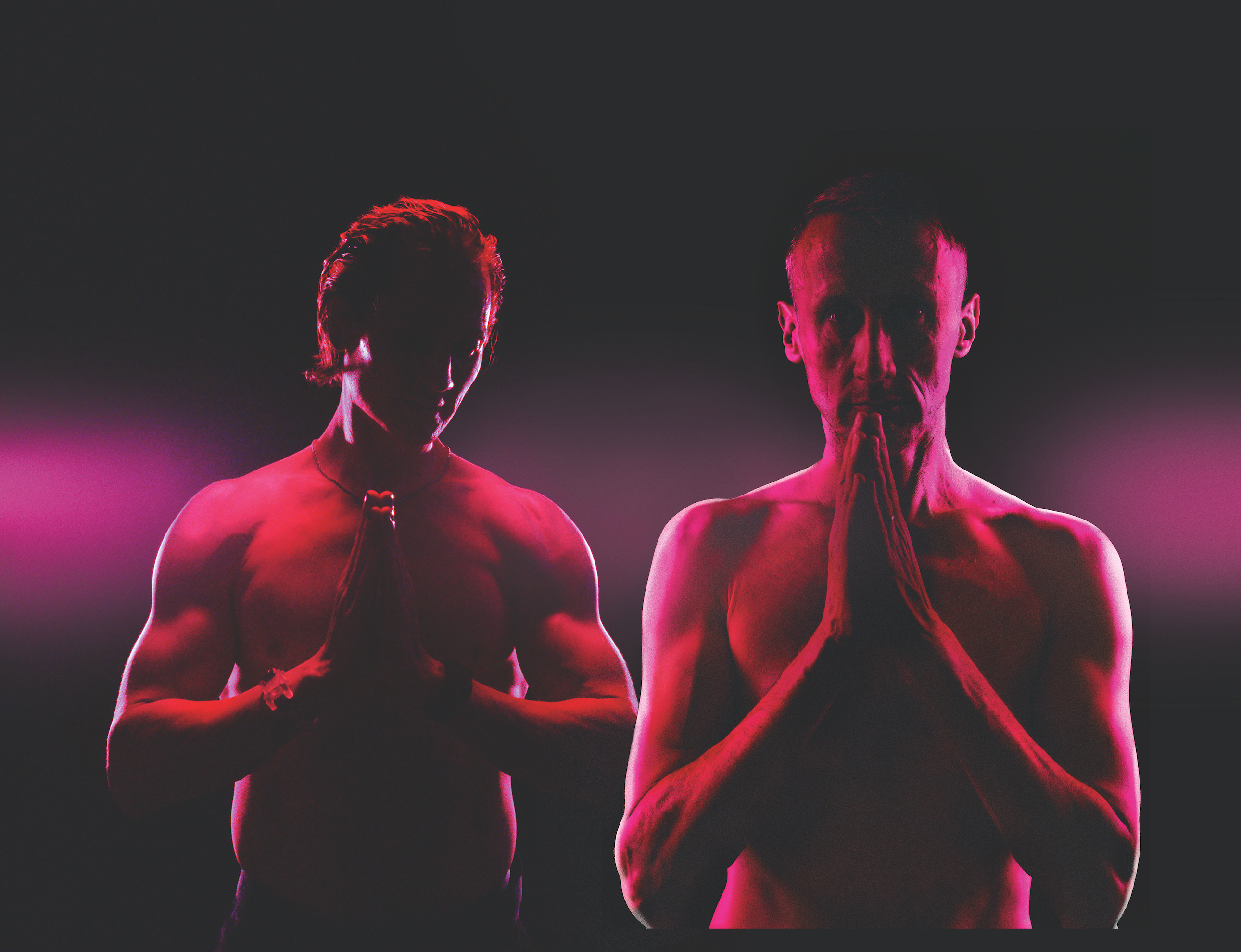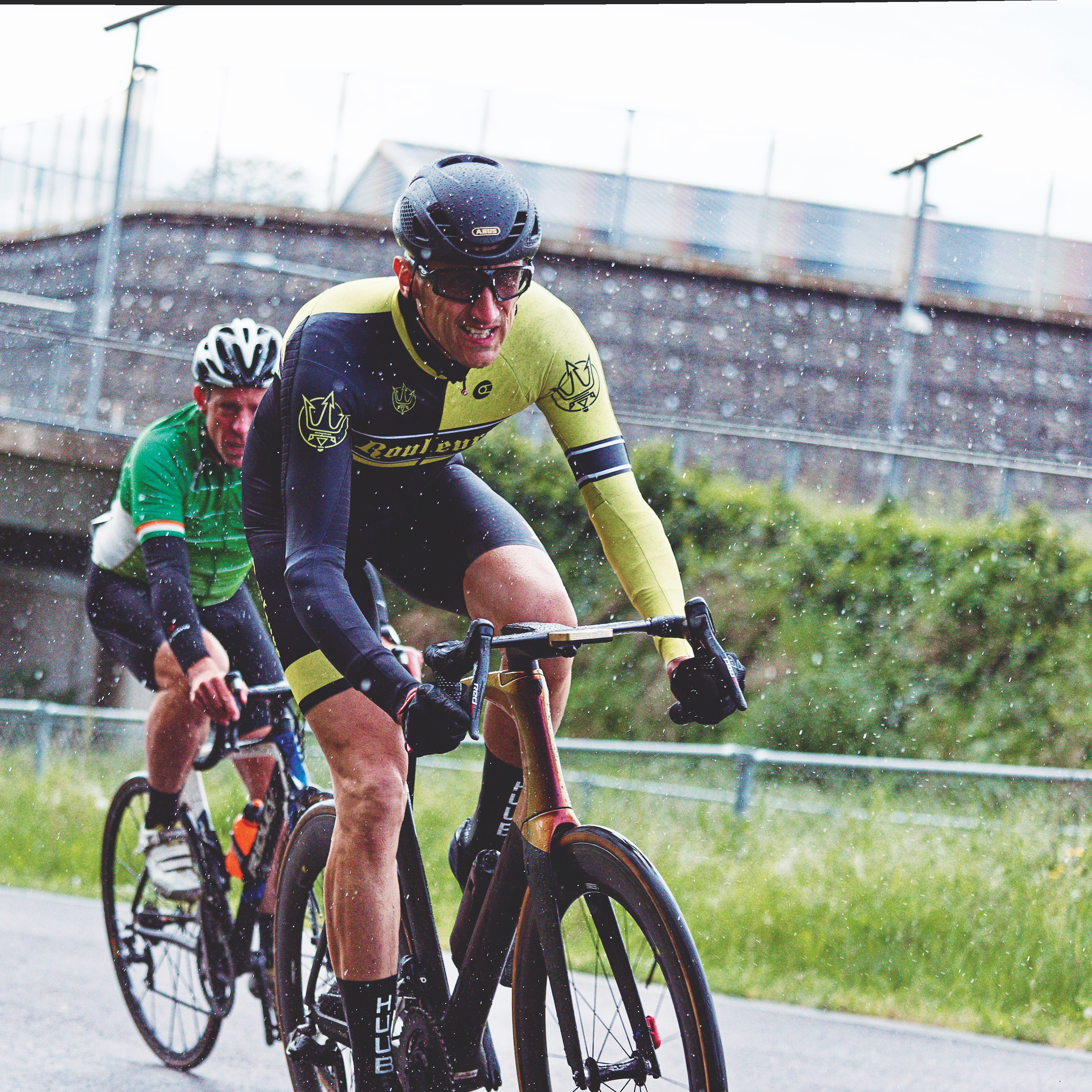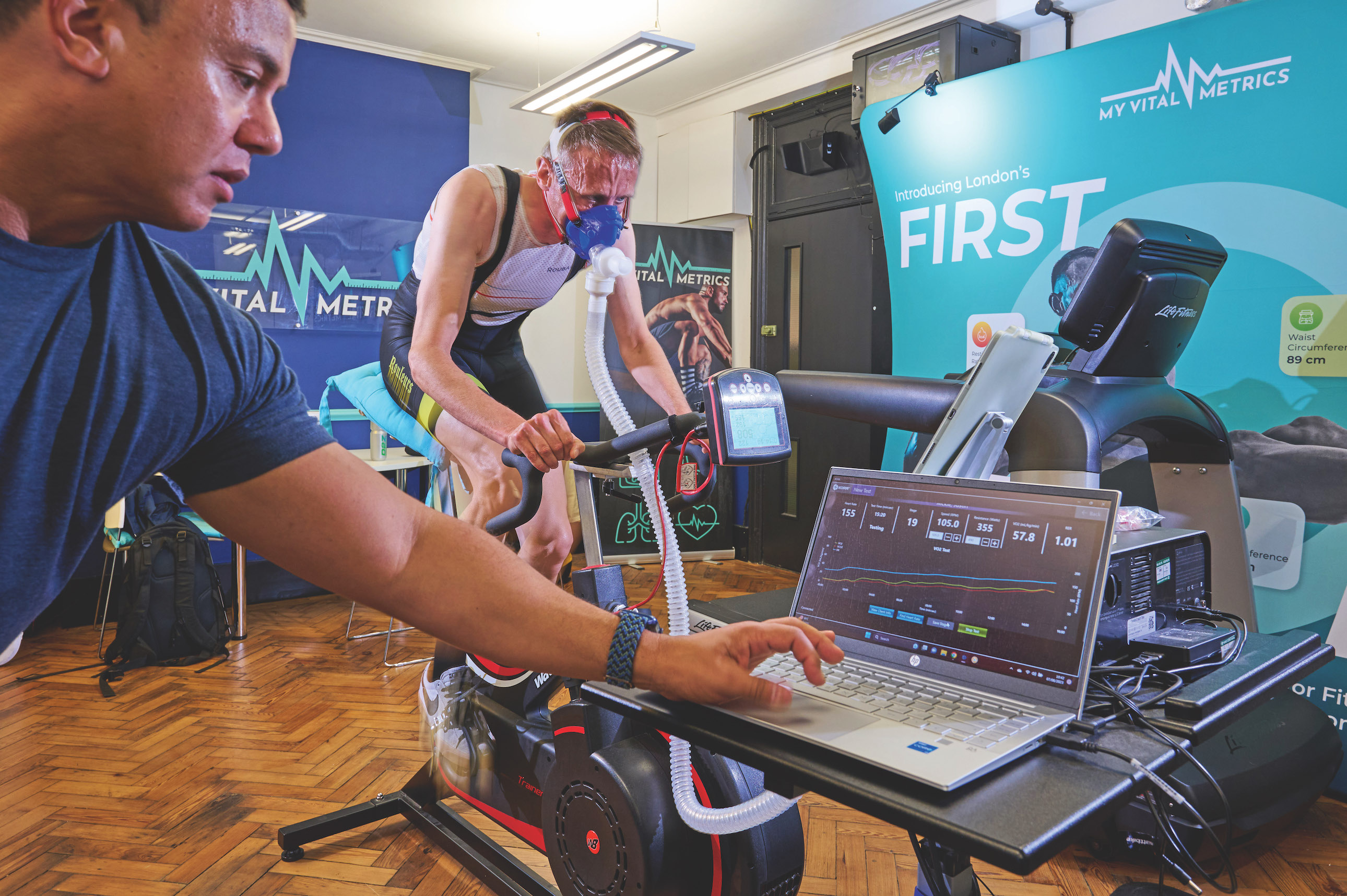Anti-aging lifestyles compared: $2m-a-year Blueprint project vs the humble bicycle
Tech entrepreneur Bryan Johnson spends millions trying to defeat the ageing process, but could regular cycling be just as effective? We decided to find out


Over the past few months, it has been hard to avoid media coverage about the US tech centi-millionaire Bryan Johnson and his quest to defy the ageing process. Hardly a news outlet in the land – not even Auntie Beeb herself – has turned down the chance to feed Johnson’s apparently insatiable appetite for publicity. Most of the headlines allude to his $2m-a-year anti-ageing budget, or the fact he was injecting himself with the blood plasma of his 17-year-old son – a vampiric practice he has since ditched, admitting it didn’t work. Among his many audacious claims, the wealthy 46-year-old purports to have slowed his pace of ageing by 31 years – but it was his boast about having a VO2 max of 58.7ml/kg/min that raised my eyebrow highest.
In fairness to Johnson, a VO2 max in the high-50s is very respectable for a man in his mid-40s, but his claim that this measurement puts him in the “top 1.5% of 18-year-olds” says a lot more about the sedentariness of the teenagers to whom he’s comparing than it does about his own peak oxygen uptake. What’s more, I knew from experience that plenty of competitive veteran cyclists of similar age to Johnson have VO2 max numbers that would make his 58 look positively geriatric. Which sparked a hypothesis in my mind: if cycling maintains cardiovascular performance more effectively than a $2m-a-year anti-ageing regime, maybe a bike is the only rejuvenation tool any of us really need.
To put this hypothesis to the test, I decided to track down a super-fit veteran racer on whom to run a series of tests to analyse, as best we could on a CW budget – slightly slimmer than Johnson’s – how effectively cycling staves off the ageing process. Of course, this would not be a scientifically rigorous study, but it might just provide a vivid enough snapshot to help answer our modest question: is cycling the most powerful anti-ageing technique known to humanity?
Enter Justin McKie, a veteran racer who volunteered to be our guinea pig. Having just turned 48, Justin is almost exactly two years older than Johnson, and he is a highly successful age-group competitor, having won bronze in the scratch race at the 2017 World Masters champs and gold in the same event at that year’s European Masters champs. In track and crit racing in the UK, he is one of the best in his age-group, regularly winning vets’ events at Lee Valley, Herne Hill and Hillingdon. So his trophy cabinet is well stocked – but is all that high-octane racing keeping him young? We were about to find out.

Justin McKie in action
Youthfulness vs fitness
Bryan Johnson’s anti-ageing ‘Blueprint’ protocol costs millions because he monitors hundreds of biomarkers by all kinds of high-tech means – including strapping a device to his penis every night to measure his nocturnal erections. Justin, on the other hand, simply gets up early and rides his bike. “I’m a member of Regent’s Park Rouleurs and we train every morning,” he says. “It’s quite a competitive group – we enjoy racing each other. My FTP [335 watts] has barely changed over the past seven years.” Typically for a competitive amateur, Justin does eight to 10 hours of training every week, with at least two interval sessions. Meanwhile, Johnson’s exercise regime is much less arduous: just one hour a day of stretching and strength moves, plus a 10-minute HIIT session three times a week.
To lay down some physiological markers to compare with Johnson’s, we meet Justin at My Vital Metrics in central London to test not only his fitness but his body composition too. First up is a ramp test to ascertain his VO2 max, and it comes as little surprise when he records an excellent 65.6ml/kg/min, smashing Johnson’s comparatively paltry 58 out of the park. This means the older man’s cardiovascular system is able to operate at a much higher maximum, and in a bike race, he would leave Johnson for dust. What this means for their respective ageing rates we’ll worry about later; for now, it’s one-nil to Justin.
The next test for Justin is a welcome lie-down: flat on his back, the DEXA scanner buzzes over him, invisibly sampling the density of his tissues. Very tall and rangy, at 6ft 4in, Justin has long, lean limbs, and clearly isn’t carrying much if any excess weight. The test confirms it: his 11% body fat – accounting for less than 9kg of his 79.1kg total mass – puts him at the leaner end of the healthy range. Bryan Johnson takes leanness to the extreme, eating just 1,977 calories a day to maintain ultralow body fat of 6.9%. His spartan diet is strictly vegan, includes every imaginable supplement – more than 100 pills daily – and his final meal of the day is eaten at 11am.
The latest race content, interviews, features, reviews and expert buying guides, direct to your inbox!
Dietary differences aside, this much is clear: both men are lean and in very good physical shape for their age. This is backed up by their appearance: Justin has an could easily pass for early-40s, whereas Johnson has – to purloin a spot-on description from a recent Time magazine feature – “the body of an 18-year-old and the face of someone who had spent millions attempting to look like an 18-year-old”. In terms of cardiovascular fitness, Justin is streaks ahead, owing to his bike training, whereas Johnson’s regime has just one objective: to slow down ageing. But does this mean that the high volume and intensity of Justin’s cycling negates some of the benefits? Back home from the lab tests, it was time to consult some experts.

Justin McKie gets his VO2 max tested at London lab My Vital Metrics
The case for exercise
Richard Faragher is a professor of biogerontology – the biology of ageing – at the University of Brighton. When I email him, he replies within minutes, suggesting I call straight away, as he’s shortly dashing off to play squash. “It should be framed like this,” the no-nonsense prof cuts directly to the nub of my question. “If exercise were a drug, what’s the correct dose? You have to trade off damage from doing the exercise with the benefit gained from it.” He admits that science has not yet been able to define where that line falls – but it can offer a rule of thumb. “Being sedentary is very bad for you; exercising like a madman isn’t great either.”
Faragher references a 2018 study by his colleague Janet Lord at the University of Birmingham, which examined 125 well-trained amateur cyclists aged 55 to 79, and found that their immune function – production of new immune T cells – was not only significantly higher than in less active counterparts of the same age but was, on average, on a par with that measured in young people aged 20-36. “What’s going on there,” explains Faragher, “is that we have an organ called the thymus, effectively a school for T cells, which in men atrophies with age – by the time you’re my age [Faragher is 56] you don’t have a thymus left and instead rely on your peripheral T cell pool. This is why most older men die of infection.” Amazingly, lifelong cyclists seem to preserve their thymus and thereby extend youthful immune function for years, perhaps decades, longer than inactive people.
You might presume that keeping the body in a state of rest, hiding away on the sofa, would slow down ageing by minimising wear and tear – but the opposite is true. Being long-term inactive is deadly – even deadlier than piling on excess weight. Faragher references a huge population study, Epic-Norfolk, which found that a lack of exercise was responsible for twice as many deaths as obesity. Despite being immersed in the complexities of ageing, the professor’s advice is very simple. “Get the basics right,” he says so firmly he’s almost shouting. “Take regular exercise, don’t smoke, drink in moderation, watch your weight and eat plenty of fruit and veg. The difference in life expectancy between someone who does four of these five behaviours and someone who does none of them is 15 years.” Full marks to Justin, then, who does all five.
While Faragher is not exactly dismissive of Bryan Johnson’s anti-ageing project – “it’s obsessive, kind of bizarre, but OK, fine” – he regards it as speculative and experimental rather than guided by scientific consensus. For a second opinion, I turn to David Gems, professor of biogerontology at UCL, and I want to know whether Johnson is justified in limiting his energy intake to stay ultra-lean. “Caloric restriction is a very complex topic,” Gems sighs. “In laboratory conditions, when you reduce the food intake of rats and mice by 70% from the ad libitum [without restriction] amount, you see striking increases in lifespan.” This goes beyond dieting, he points out – the level of restriction is so extreme it holds back growth and fertility. “The question is whether reducing the weight of a human who already has a healthy BMI increases their lifespan,” continues Gems, “and the evidence is absolutely not there.”

Bryan Johnson experimented with injecting the blood plasma of his teenage son, Talmage
The lab results
It is well established in sports science that a chronic energy deficit – eating less than you burn – disrupts hormone levels and can lead to serious health problems. Johnson, who publishes his biomarker data, has divulged that he takes supplementary testosterone in the form of patches; he has also taken human growth hormone. Whether the need for top-up hormones arose from the effects of his caloric restriction, we can’t be sure – Johnson declined CW’s request for an interview – but it seems likely. What we do know is that Justin’s entirely natural testosterone level of 16.5nmol/L sits well within the healthy range and requires no augmentation.
Mimicking Johnson’s data-centric approach as closely as we could afford, we sent off a sample of Justin’s blood to test for 15 key biomarkers. Knowing the results would be sent directly to sports endocrinologist Dr Nicky Keay for analysis, I leave it a week and then call her for a run-down. “This is interesting,” she says. “Testosterone tends to decline with age, but Justin’s levels are perfectly respectable – lots of much younger men would be happy with 16.5nmol/L. Johnson’s may be higher, at 26.7nmol/L, but he’s taking an external form, which is frankly stupid.” Through gritted teeth, Keay explains that taking extra testosterone runs the risk of suppressing other hormones and throwing the body’s natural balance out of kilter. It is also, as struck-off doctor Richard Freeman can attest, strictly prohibited in cycling.
“Overall, I cannot fault Justin’s blood profile,” says Keay, glowingly. She is particularly impressed by the oxygen-carrying components, all at near-optimum levels. “This shows he is definitely taking in enough nutrients to make the red blood cells, and they are at a really good level – absolutely excellent.” Cholesterol, inflammation and blood glucose control are increasingly liable to go haywire as we grow older, but again, in these areas, Justin’s results have only good news to tell. “From the evidence we have here, his cardiovascular and metabolic health are excellent,” adds Keay. “A pro cyclist in their 20s would be delighted with this set of results.”
The hormone specialist is alluding here to the fact that many pro riders exert themselves so strenuously that they end up with suppressed testosterone and elevated markers of inflammation. You might think this would hasten ageing and shorten life expectancy, but the evidence suggests not. A 2011 study compared the longevity of 834 cyclists who competed in the Tour de France between 1930 and 1964, and found that their average longevity was 81.5 years – a 17% longer life, on average, than the general population of their day. (While I was researching for this feature, the winner of the 1959 Tour, Federico Bahamontes, died at the grand old age of 95, as if to stress the point.)
There is plentiful evidence that the life-extending benefits of cycling are reaped by amateur riders too. A mega-review of more than 5,000 studies published in the BMJ in 2019, found that individuals who regularly cycled had a 22% lower risk of developing cardiovascular disease, and/or dying from it, compared to those who didn’t cycle. All of the data points to the conclusion that, owing to his lifestyle in general and his cycling habit in particular, Justin is giving himself the best possible chance of living a long, healthy life. Whether or not his simple formula will beat Johnson’s very elaborate one, only time will tell.
Slave to the algorithm
There is a raft of evidence for the health-bestowing, age-defying effects of regular cycling – we’re all refilling our bidons at the fountain of youth. But it’s important we don’t get carried away; cycling cannot recolour grey hair, magic away wrinkles, nor defeat death – we’ll leave that to Bryan Johnson. His Blueprint project is not simply about staying healthy or looking ripped; he wants to override fallible human choices (to eat junk, get drunk, etc) by letting algorithms take control – the end goal being to render death “not inevitable”. Yes, he actually says that. He’s also fond of saying “the mind is dead,” as though outsourcing all decision-making to indifferent machines is a sunny prospect.
Our guinea pig Justin is nothing like Bryan Johnson. He did not take up cycling to slow down the ageing process, and he is under no illusion that his hectic, high-achieving schedule is ideal for long-term health. Indeed, the DEXA scan showed that he has a mild degree of bone density deterioration in his lumbar spine – typical among high-volume cyclists, owing to the lack of ‘osteogenic’ loading. In any case, he’s already sensitive to the potential downsides of high-workload training, having been shaken up by a heart arrhythmia scare a few years ago (he has since been given the all-clear).
When we catch up after the lab tests, I ask Justin directly: had he given much thought to ageing before getting involved in this feature? “Reading The Midlife Cyclist by Phil Cavell last year had a dramatic impact on me,” he reflects. “Someone in their 40s today might be fitter and faster than an 18-year-old was 100 years ago, but if you’re doing a very high volume of training, it may cause certain health issues and add less to your lifespan than just being generally active.” Soon to start a demanding new job running the investment management wing of a Swiss bank in London, he admits that his life priorities are starting to shift. “As I approach 50, ageing is more on my mind,” he says. “Although I want to remain as active as possible, I need to find a balance.” Does this mean reining in his racing? “Yeah, it’s on my mind. It’s not retirement as such but I don’t expect to race so much for a while.”
The next day, I receive a follow-up email from Justin – he wants to add a personal detail. “One perhaps critical thing I missed,” he writes, “was that my father died of a massive heart attack in his early 50s – a few years older than I am now. He was nearly twice my weight, smoked and had type-two diabetes. It’s a stark contrast to the way I have chosen to live my life, of course, but indirectly I think he probably influenced me more than I thought.”
| Row 0 - Cell 0 | Bryan Johnson | Justin McKie | Healthy range |
| Age | 46 | 48 | n/a |
| Height | 6ft 0in | 6ft 4in | n/a |
| Weight | 72.9kg | 79.1kg | n/a |
| Body fat % | 6.9% | 11% | 11–22% |
| BMI | 22.8 | 21.2 | 18.5–24.9 |
| Epigenetic rate of ageing | 0.69* | 1.0 | <1.0 |
| VO2 max | 58.7 ml/kg/min | 65.6 ml/kg/min | >52.5 ml/kg/min (top 5% for age) |
| Cholesterol (total) | 4.1 mmol/L | 4.4 mmol/L | <5 mmol/L |
| Testosterone | 26.7 nmol/L | 16.5 nmol/L | 9–37 nmol/L |
| White blood cells | 4.5 10^9/L | 8.5 10^9/L | 4–11 10^9/L |
| Thyroid stimulating hormone | 1.9 mIU/L | 2.5 mIU/L | 0.4–4.0 mIU/L |
| C-reactive protein (marker of inflammation) | 0.46 mg/L | 0.24 mg/L | <1.0 mg/L |
| HbA1c (marker of blood glucose control) | 25.6 mmol/mol | 35.0 mmol/mol | 20–48 mmol/mol |
* Johnson’s 0.69 (tested by TruAge) suggests molecular ageing patterns similar to someone aged 32 (46 years x 0.69), whereas Justin’s 1.0 (tested by Muhdo) puts his cellular ageing rate exactly in line with his chronological age of 48.
What's the best benchmark of ageing?
Bryan Johnson tests all manner of biomarkers in his quest to defeat ageing, but none of them is an infallible yardstick for exactly how quickly he is ageing or, in other words, precisely what will kill him and when. Ironically, the more reliable tell-tale signs of how fast someone is ageing might be far simpler.
A recent systematic review of studies confirmed that people judged as looking older do indeed have a greater risk of dying compared to those who look younger. Looking older was found to correlate to health problems such as heart issues, memory function, bone strength, and lung disease. “Skin has a variety of functions,” says Richard Faragher, “one of which is to signal our health to other humans. When you observe older-looking skin, you’re picking up on a series of health changes.”
Another scientifically verified predictor of health status is grip strength. We tested Justin’s and he squeezed 512N with his left hand and 550N with his right. Anything above 300N is regarded as normal strength for a man in his mid-40s, so he’s in the clear. He’s out-clenched by Johnson, however, who reports a squeeze of 552/597N – bear in mind, though, that grip strength is trainable. Both men should breathe a sigh of relief, given Faragher’s pithy conclusion: “People with weak grip strength tend not to keep the churchwarden waiting.”
What is ageing?
All of us grow old, but what exactly is ageing – what’s going on in the body to make our hair go grey, our skin wrinkle and our bodily functions become slowly but surely less dependable? It’s tempting to assume that there is something like a clock encrypted in our DNA counting down the time we have left. But that’s an unhelpful analogy, according to Professor Richard Faragher. “Organisms don’t contain self-destruct hardware,” he says. “They are more like cars – they run until something breaks.”
The body is, of course, much more complex than a car, with many more parts and processes that can go wrong. There are seven main, interlinked biological processes implicated in ageing: cellular senescence, the accumulation of jaded cells; telomere shortening, changes in the DNA at the ends of chromosomes; oxidative stress, damage from free radicals; inflammation; mitochondrial dysfunction, changes in cellular energy production; hormonal changes; and immune system decline.
“Biological ageing is at bottom very simple,” says Faragher. “Over time, you see an exponential increase in the chances of getting sick or dying, coupled with a decline in functional capacity. Interestingly, some organisms don’t do this – famously, Arctica islandica, a species of ocean clam, is non-ageing. Amazingly, Shakespeare could have eaten the oldest clams in your chowder.”
The full version of this article was published in the 19 October 2023 print edition of Cycling Weekly magazine. Subscribe online and get the magazine delivered to your door every week.

David Bradford is senior editor of Cycling Weekly's print edition, and has been writing and editing professionally for 20 years. His work has appeared in national newspapers and magazines including the Independent, the Guardian, the Times, the Irish Times, Vice.com and Runner’s World. Alongside his love of cycling, David is a long-distance runner with a marathon personal best of 2hr 28min. Diagnosed with retinitis pigmentosa (RP) in 2006, he also writes personal essays exploring sight loss, place, nature and social history. His essay 'Undertow' was published in the anthology Going to Ground (Little Toller, 2024). Follow on Bluesky: dbfreelance.co.uk